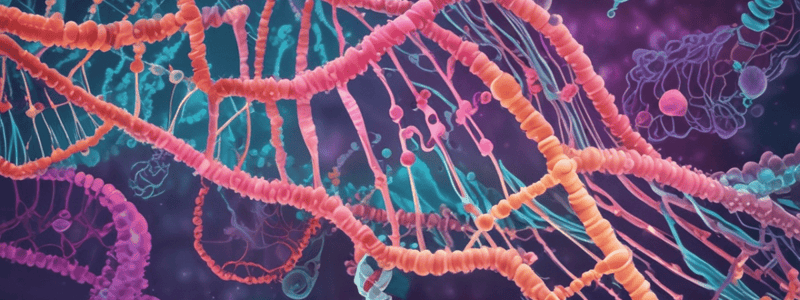Podcast
Questions and Answers
What is the benefit of tightly coupling DNA replication to the cell cycle?
What is the benefit of tightly coupling DNA replication to the cell cycle?
- To increase the activity of RNaseH
- To increase the rate of DNA replication
- To reduce the activity of topoisomerases
- To avoid aneuploidy (correct)
What is the function of ORC in the process of DNA replication?
What is the function of ORC in the process of DNA replication?
- To remove primers from the newly synthesized DNA strand
- To seal the nick between the Okazaki fragments
- To load the MCM2-7 helicase onto DNA (correct)
- To synthesize primers for DNA replication
What is the function of FLAP ENDONUCLEASE Fen1 in DNA replication?
What is the function of FLAP ENDONUCLEASE Fen1 in DNA replication?
- To synthesize DNA in the 5' to 3' direction
- To remove RNA primers from the newly synthesized DNA strand
- To create a flap structure during lagging strand synthesis
- To recognize and cut the flap structure during lagging strand synthesis (correct)
What is the function of PCNA in DNA replication?
What is the function of PCNA in DNA replication?
What is the effect of fluoroquinolones on bacterial DNA synthesis?
What is the effect of fluoroquinolones on bacterial DNA synthesis?
What is the function of DnaA protein in E. coli?
What is the function of DnaA protein in E. coli?
What is the function of DnaB helicase?
What is the function of DnaB helicase?
What is the role of single-stranded DNA-binding protein (SSB)?
What is the role of single-stranded DNA-binding protein (SSB)?
What is the main replicative enzyme in E. coli?
What is the main replicative enzyme in E. coli?
What is the function of DNA polymerase I?
What is the function of DNA polymerase I?
What is the function of RNA primer?
What is the function of RNA primer?
What is the function of beta clamp?
What is the function of beta clamp?
What is the result of replication from multiple origins of replication?
What is the result of replication from multiple origins of replication?
What is the purpose of RNaseH in DNA replication?
What is the purpose of RNaseH in DNA replication?
What is the role of MCM2-7 helicase in DNA replication?
What is the role of MCM2-7 helicase in DNA replication?
What is the function of type 1 topoisomerases in DNA replication?
What is the function of type 1 topoisomerases in DNA replication?
What is the function of DNA ligase in DNA replication?
What is the function of DNA ligase in DNA replication?
What is the effect of inhibiting type 2 topoisomerases on bacterial DNA synthesis?
What is the effect of inhibiting type 2 topoisomerases on bacterial DNA synthesis?
Where does DNA replication begin in E. coli?
Where does DNA replication begin in E. coli?
What is the function of DnaC loader protein?
What is the function of DnaC loader protein?
What is the purpose of single-stranded DNA-binding protein (SSB)?
What is the purpose of single-stranded DNA-binding protein (SSB)?
What is the name of the structure formed during bi-directional replication?
What is the name of the structure formed during bi-directional replication?
What is the function of DNA polymerase III?
What is the function of DNA polymerase III?
What is the function of primase?
What is the function of primase?
What is the function of beta clamp?
What is the function of beta clamp?
What is the result of replication from multiple origins of replication?
What is the result of replication from multiple origins of replication?
Flashcards are hidden until you start studying
Study Notes
Origin of Replication
- E. coli origin of replication is OriC, a 250bp sequence
- DnaA initiator protein binds to DnaA boxes, which are tandem repeats
- Binding of DnaA to DnaA boxes spreads to A-T rich region, leading to DNA unwinding element (DUE) causing initial separation of strands
DNA Unwinding and Replication
- DnaB helicase unwinds dsDNA, using ATP and forming a hexameric ring
- DnaB helicase causes unwinding by translocating on ssDNA, using steric exclusion to separate it from other strand
- DnaC loader protein opens and loads helicase ring
- Single-stranded DNA-binding protein (SSB) prevents reannealing behind helicase, stabilizing ssDNA
Replication Fork and DNA Polymerases
- Creation of replication bubble from bi-directional replication, leading to Y-shaped replication forks
- E. coli has 5 DNA polymerases (I-V), with DNA pol III being the main replicative enzyme
- DNA pol I has a specialized role in nick-translation during Okazaki fragment processing
RNA Primer Synthesis and Processing
- Primase synthesizes RNA primer on template DNA, using DNA-dependent RNA polymerase
- Okazaki fragments in bacteria are 1000bp, while in eukaryotes they are 100-200bp
- DNA pol III stalls when it encounters RNA, and DNA pol I has 5’-3’ exonuclease activity to chew up RNA primer and replace with DNA
Replication Process
- Processivity is the ability of polymerase to synthesize without stopping
- DNA pol III relies on beta clamp for processive synthesis
- Two DNA pols work together at replication fork, forming replisome, with leading and lagging strand synthesis coupled in trombone model
- Multiple origins of replication, with yeast having defined origins called autonomously replicating sequences (ARSs)
Eukaryotic DNA Replication
- Eukaryotic DNA replication is tightly coupled to cell cycle to avoid aneuploidy
- Origin licensing in G1, when MCM2-7 helicase is loaded onto DNA by ORC
- Origin firing at beginning of S-phase
- Primers removed by RNaseH, which digests RNA base paired to DNA
- Replicative DNA pol displaces residual primer, creating flap, then recognized and cut by flap endonuclease Fen1, nick sealed by DNA ligase
Topoisomerases
- Topoisomerases relieve topological tension in DNA and untangle
- Type 1 nick ssDNA and pass it around the other strand before resealing
- Type 2 cut both strands of one duplex, allowing another duplex through the gap, re-sealing
- Reactions proceed via covalent protein-DNA attachment
Cellular Proliferation
- MCM used as markers for cellular proliferation
- Fluoroquinolones inhibit type 2 topoisomerases and disrupt bacterial DNA synthesis
Origin of Replication
- E. coli origin of replication is OriC, a 250bp sequence
- DnaA initiator protein binds to DnaA boxes, which are tandem repeats
- Binding of DnaA to DnaA boxes spreads to A-T rich region, leading to DNA unwinding element (DUE) causing initial separation of strands
DNA Unwinding and Replication
- DnaB helicase unwinds dsDNA, using ATP and forming a hexameric ring
- DnaB helicase causes unwinding by translocating on ssDNA, using steric exclusion to separate it from other strand
- DnaC loader protein opens and loads helicase ring
- Single-stranded DNA-binding protein (SSB) prevents reannealing behind helicase, stabilizing ssDNA
Replication Fork and DNA Polymerases
- Creation of replication bubble from bi-directional replication, leading to Y-shaped replication forks
- E. coli has 5 DNA polymerases (I-V), with DNA pol III being the main replicative enzyme
- DNA pol I has a specialized role in nick-translation during Okazaki fragment processing
RNA Primer Synthesis and Processing
- Primase synthesizes RNA primer on template DNA, using DNA-dependent RNA polymerase
- Okazaki fragments in bacteria are 1000bp, while in eukaryotes they are 100-200bp
- DNA pol III stalls when it encounters RNA, and DNA pol I has 5’-3’ exonuclease activity to chew up RNA primer and replace with DNA
Replication Process
- Processivity is the ability of polymerase to synthesize without stopping
- DNA pol III relies on beta clamp for processive synthesis
- Two DNA pols work together at replication fork, forming replisome, with leading and lagging strand synthesis coupled in trombone model
- Multiple origins of replication, with yeast having defined origins called autonomously replicating sequences (ARSs)
Eukaryotic DNA Replication
- Eukaryotic DNA replication is tightly coupled to cell cycle to avoid aneuploidy
- Origin licensing in G1, when MCM2-7 helicase is loaded onto DNA by ORC
- Origin firing at beginning of S-phase
- Primers removed by RNaseH, which digests RNA base paired to DNA
- Replicative DNA pol displaces residual primer, creating flap, then recognized and cut by flap endonuclease Fen1, nick sealed by DNA ligase
Topoisomerases
- Topoisomerases relieve topological tension in DNA and untangle
- Type 1 nick ssDNA and pass it around the other strand before resealing
- Type 2 cut both strands of one duplex, allowing another duplex through the gap, re-sealing
- Reactions proceed via covalent protein-DNA attachment
Cellular Proliferation
- MCM used as markers for cellular proliferation
- Fluoroquinolones inhibit type 2 topoisomerases and disrupt bacterial DNA synthesis
Studying That Suits You
Use AI to generate personalized quizzes and flashcards to suit your learning preferences.


